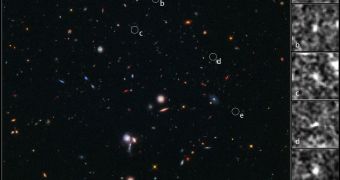A new survey of the near-infrared sky has revealed the oldest protocluster of galaxies in the Universe. The forming structure was discovered using the NASA Hubble Space Telescope, which conducts studies in near-infrared and optical wavelengths.
According to astronomers, the cluster Hubble identified recently is not yet formed, but rather in its earliest stages of development. This makes a lot of sense, considering that the formation is more than 13.1 billion light-years old.
What this means is that the Universe itself was only 600 million years old at that time. Current astronomical models do not really allow for such complex structures to have existed so close to the Big Bang. Yet, data are revealing that this was indeed the case.
Usually, clusters are made up of hundreds to thousands of galaxies, but experts operating Hubble were only able to see 5 galaxies in this particular one. Undoubtedly, the formation grew in size over the years, and is now one of the largest of its kind in the Universe.
Some astronomers believe that it may even be larger than the Virgo cluster, a collection of 2,000+ galaxies towards which both the Milky Way and Andromeda are currently heading. The latter two will collide with each other long before they meet up with Virgo.
The ancient protocluster galaxies “formed during the earliest stages of galaxy assembly, when galaxies had just started to cluster together,” explains University of Colorado in Boulder (UCB) astronomer Michele Trenti. The expert is also based at the University of Cambridge Institute of Astronomy.
“The result confirms our theoretical understanding of the buildup of galaxy clusters. And, Hubble is just powerful enough to find the first examples of them at this distance,” the investigator goes on to say.
Details of the research were presented yesterday, January 10, at the 219th meeting of the American Astronomical Society (AAS2012), which was held in Austin, Texas. The study was accepted for publication in an upcoming issue of the esteemed Astrophysical Journal.
According to Trenti, discovering an old protocluster is not the simplest thing in the world. These structures are unbelievably rare, extremely scattered across the sky, and also very dim. As such, searching for them is like looking for a needle in a very big haystack.
“We need to look in many different areas because the odds of finding something this rare are very small. The search is hit and miss. Typically, a region has nothing, but if we hit the right spot, we can find multiple galaxies,” Trenti concludes.

 14 DAY TRIAL //
14 DAY TRIAL //